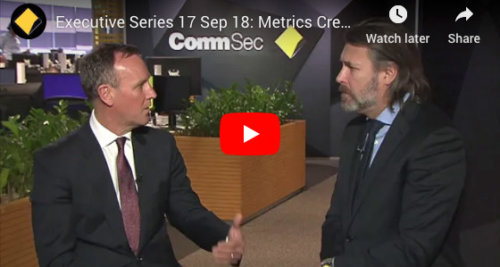An investment offering a balance between volatility and yield
The COVID-induced market crash of 2020 has rattled both new and experienced investors by underscoring the pitfalls of over-allocating to growth assets. For owners of high-yield stocks, last year’s roller-coaster was compounded with the sting of dividend cuts. And it’s for these reasons alternatives such as private debt are experiencing a spike in interest, according to Andrew Lockhart, Partner at Metrics Credit Partners.
“What investors have really been looking for is ways they can reduce that market volatility and then how they can get an acceptable return?”
While dividends for banks were gutted or eliminated, credit strategies such as Metrics’ LITs continued pumping out monthly income while their unit prices recovered relatively quickly. And with the Australian economy charging above pre-pandemic levels, Lockhart says the opportunities to lend and make a solid return above the cash rate are hot.
In this interview, Lockhart expands on the benefits of private loans as an asset class and discusses the drivers of current lending opportunities, and which debt investments will outperform in an inflationary environment.
Edited transcript
Where are you seeing opportunities for lending in the market right now?
Demand for credit is strong, the economic conditions are buoyant. And we really started to see that in our own funds, in terms of the companies that we provide financing to, really turn very early on in 2020. So we obviously had a fairly substantial market dislocation through March, April and May of last year. But then what we saw was the companies that we were financing, their confidence in terms of their future performance was quite strong. And so really from toward the backend of the lockdown in Victoria, and we really did start to see confidence building across the companies that we lend to, we actually saw them outperforming what were pretty strong stretched budgets. So the demand for credit is strong, interest rates are low, and so we’re seeing a lot of activity.
The two real drivers for us in terms of demand for credit really come from two sources. One is commercial real estate related activity is a big consumer of capital for us. The other area of demand for credit really comes from acquisition financing. So we support and provide financing to a range of private equity firms that are active. And so if you see company acquisitions and those private equity firms selling their existing portfolio companies, a lot of that creates opportunities for us to lend to those companies.
Why are investors seeking alternatives in this environment?
I think a lot of investors have been looking for alternatives. They’ve experienced the situation where they’ve been subjected to quite substantial bouts of volatility in public markets, particularly in that market dislocation period in early 2020. And I guess what investors are really been looking for is ways in which they can reduce that market volatility, and then how do they get an acceptable return. And I think one of the things that were obvious in 2020 was the volatility, not only in terms of the market pricing but also particularly if you’re an investor that’s invested in equities to receive an income, the cuts to dividends were quite tough as well.
And so I think a lot of investors have looked at their portfolios and said, ‘I’ve got a lot of equity exposure, how can I best diversify my exposures or my assets?’ We present an attractive alternative for investors where they’re looking for more stable capital in terms of lower risk of volatility, but also where we present an opportunity to receive a regular income. And so the income that we pay across our funds is distributed to investors on a monthly basis. So that’s been attractive. We’re seeing a lot of interest from institutional investors, we have a number of large insurance groups, for instance, that have invested in our funds, superannuation funds, we’re even seeing a lot of demand growth from a range of offshore investors looking to access our funds.
What’s the advantage of investing in debt versus equity?
I think one of the things that have been interesting is whilst public markets have been quite volatile, what you’ve seen in our asset class is more stability of capital, really due to the protections that are afforded to an investor in debt. So as a lender, what I want to do is ensure that I’ve got appropriate terms and conditions and controls imposed on the borrower to ensure that our investor’s capital is not at risk of loss. So equity will wear the volatility, equity should be the asset class investors are investing in for growth. You invest in the debt part of the capital structure to receive a return and ensure you’ve got the benefit of the protections associated with the security that you take over the company, the covenants, the controls, they’re designed to be mitigants to the risk of loss. And so a lot of investors are saying, ‘that’s an attractive asset class for us’. If you can get a reasonable return and you’ve got lower levels of volatility of your capital, then you can see it becomes an attractive alternative, particularly when interest rates and other alternatives are not delivering the income that investors demand.
Which debt securities are well-positioned for rising inflationary pressures?
I think at the end of it, interest rates are low, we’ve had material cuts, there are concerns building in the market around future rises to inflation. And so I guess you don’t want to be in an investment product or a debt product that has exposure to fixed rates. And so obviously if you’re involved in an asset class like ours, if interest rates were to rise, inflation was to rise, then the total return that you as an investor will receive will increase as the base rates flow through in terms of higher total returns to an investor. So what I think are the important characteristics of investing in debt are short-dated exposures, inflating rate instruments are particularly attractive. Short-dated, because it reduces your risk around credit risk, it reduces the market volatility and market risk that you take. Plus it also gives you, as a lender, a more frequent opportunity to generate fees from refinancing events. So they’re the sorts of things that we try to deliver for our investors.
8 July 2021 – An investment offering a balance between volatility and yield
Other News
Podcast: The Rules of Investing | From Cold Call to Capital Giant
In this episode of The Rules of Investing, Metrics Group CEO & Managing Partner, Andrew Lockhart discusses the conditions that…
Metrics Credit Partners Completes Acquisition of Taurus and BC Invest
Metrics Credit Partners (“Metrics”), a leading Australian based alternative asset management firm, has today successfully completed the acquisition of Taurus…
INSIGHTS
MCP Income Opportunities Trust (MOT) lists on ASX
Sydney, 29 April 2019: The Trust Company (RE Services) Limited (ABN 45 003 278 831) (Responsible Entity) is the responsible…
MCP Master Income Trust wins Lonsec Listed Fund Award
The award came a year after MXT was listed on the Australian Securities Exchange






